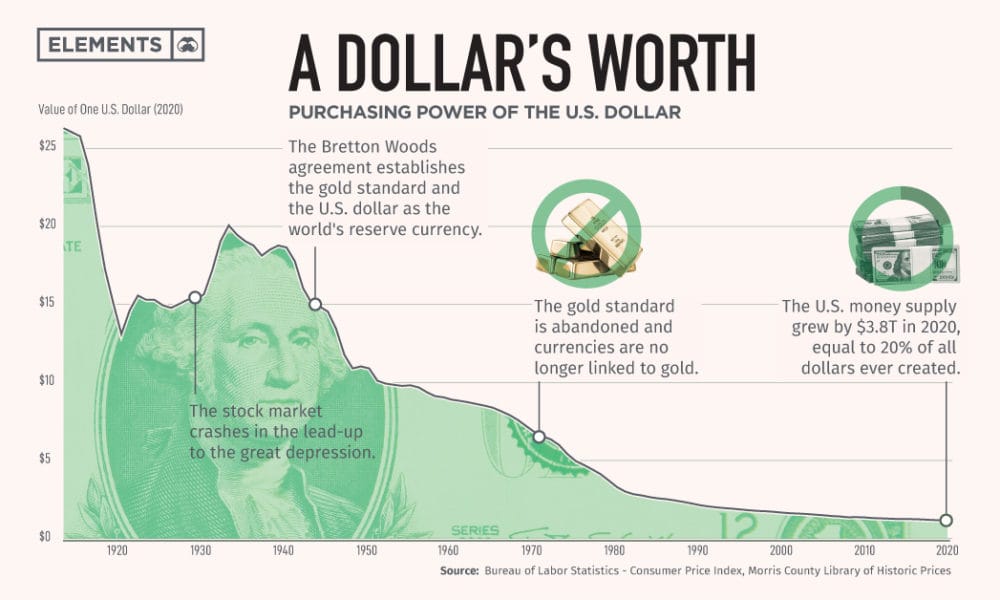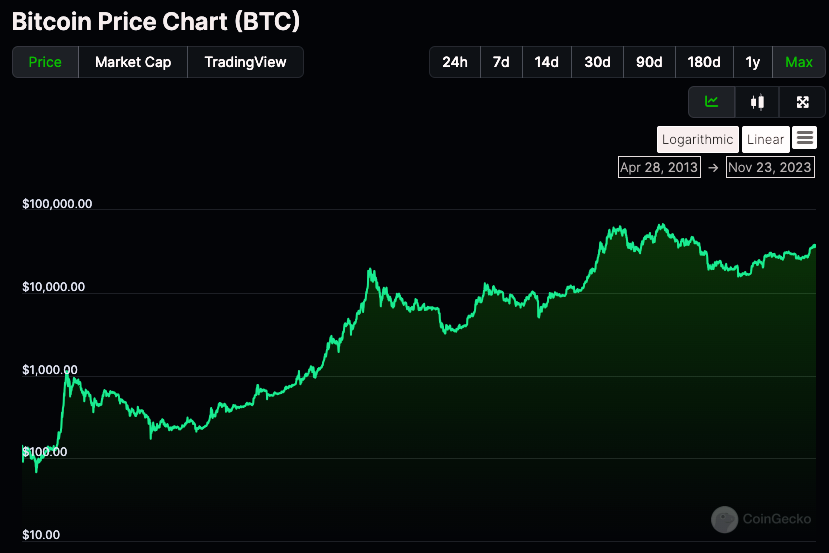Bitcoin 2.0: Kaspa, The First Stateless, Digital, Hard Cash.

From FIAT to Bitcoin (BTC) to Kaspa (KAS) - A Three-Part Analysis.
TL;DR Overview
FIAT Standard:
- Devaluation: Since 1914, Major FIAT currencies like the Pound Sterling and US dollar have lost more than 95% of their value relative to gold.
- Inflation and Investments: In 1971, the dollar was de-pegged from gold, making dollars bad for saving. Inflation spiked. In response, people started investing in stocks and bonds to keep up with inflation.
- Hyperinflation Risks: The inherent risk of hyperinflation in fiat systems due to unbacked currency issuance.
- Massive Currency Issuance: More than 80% of the USD ever existed has been printed since 2008 (when the Bitcoin Whitepaper was published).
- Growing Wealth Gap: Low and middle-class individuals lack investments that appreciate in value in pace with excess money printing, making them poorer due to cash currency debasement.
Bitcoin (BTC) as an Alternative
- Digital Gold: Bitcoin's emergence as a digital alternative to gold, offering a deflationary model and independence from government control.
- Investment Shift: Growing preference for Bitcoin over traditional assets due to its potential to outperform amidst fiat inflation.
- Scalability Challenges: Bitcoin faces scaling issues that hinder its effectiveness as a medium of exchange, preventing it from fulfilling Satoshi's peer-to-peer electronic cash vision.
- Decentralization Issue: Due to institutions launching their ETF products and buying the Bitcoin mining companies, Bitcoin will become more centralized and controlled by giants like Blackrock
Bitcoin 2.0: Kaspa ($KAS) The first digital, hard-cash
- Fair and Decentralized Launch: Like Bitcoin, Kaspa had a fair launch without any pre-mine or ICO, ensuring equal footing for all participants.
- Addressing Bitcoin's Limitations: Utilizing BlockDAG technology, Kaspa has significantly improved upon Nakamoto's Proof-of-Work algorithm. This innovation allows the chain to be faster than traditional blockchain systems, currently running 10BPS on testnet, aiming for 100 blocks per second, which eventually means a 60.000x faster block production rate (and thus scalability) than Bitcoin's.
- Technological Innovations: The integration of GHOSTDAG and DAGKnight protocols enhances transaction speed and security while maintaining the robustness of Proof of Work. Kaspa's use of Rust for application development further amplifies its potential to become not just a medium of exchange but programmable money.
- Decentralized Emission: Kaspa's rapid emission schedule and unique algorithm ensured a fair coin distribution, favoring ordinary CPU/GPU miners over ASIC operations for the first 18 months. @BITMAINtech took about a year and a half to develop Kaspa-specific miners. During this period, 70% of $KAS was distributed to individuals using basic computing equipment, preventing centralization and promoting widespread ownership.
- Decentralized Token Distribution: The largest $KAS holders have no more than 1,55% of the total circulating supply.
Chapter 1: The Flaws of the Fiat Monetary System
An Analysis of Devaluation, Inflation, and Economic Disparities

The journey of fiat currencies, particularly the Pound Sterling and the US dollar, since 1914, has been marked by significant devaluation and economic challenges. This essay delves into the critical aspects of the fiat standard, exploring its impact on economies and individuals.
- Devaluation Relative to Gold: Since 1914, major fiat currencies have experienced a dramatic loss in value, exceeding 95% when compared to gold. This devaluation reflects the inherent instability and lack of intrinsic value in fiat currencies.
- Post-Gold Standard Era: The detachment of the dollar from the gold standard in 1971 was a watershed moment, leading to increased inflation rates. This shift rendered fiat currencies less reliable for saving, prompting investors to seek refuge in stocks and bonds to mitigate the effects of inflation.
- Hyperinflation and Currency Issuance: The risk of hyperinflation, a significant concern in fiat systems, is exacerbated by the unbacked issuance of currency. Notably, about 80% of the current USD in circulation has been printed since 2008, highlighting the extent of currency expansion and its potential implications.
- Wealth Gap Exacerbation: The rampant money printing and subsequent inflation have disproportionately affected lower and middle-class individuals. These groups often lack access to appreciating investments, resulting in a widening wealth gap as their cash holdings lose value due to currency debasement.
In conclusion, the fiat monetary system, characterized by its detachment from tangible assets like gold, has led to significant economic challenges, including devaluation, inflation, and growing wealth disparities.
Chapter Two: The Bitcoin Standard
The Bitcoin Standard - Evolution and Impact

The inception of Bitcoin in 2008 by Satoshi Nakamoto marked the beginning of a new era in digital currency.
Nakamoto's creation was not just a technological breakthrough but also a response to the financial crisis and the limitations of fiat currency systems.
Designed as a decentralized, peer-to-peer electronic cash system, Bitcoin sought to empower users with a digital alternative free from government control.
At its core, Bitcoin is built on blockchain technology, leveraging cryptographic techniques to ensure secure and transparent transactions. This innovation promised a new form of money that was both secure and easily transferable, challenging traditional financial systems with its decentralized nature.
However, Bitcoin's journey has been marked by a significant shift from its original vision. While intended as a medium of exchange, it has increasingly become viewed as a store of value, akin to digital gold. This shift is partly due to scalability challenges that have limited its capacity for handling transactions at the scale initially envisioned by Nakamoto. The blockchain's limited throughput and high transaction fees have been barriers to its widespread use as everyday currency.
In addressing these challenges, solutions like the Lightning Network have emerged, aiming to increase transaction capacity and reduce costs, thereby bringing Bitcoin closer to its original purpose.
Despite these scalability issues, Bitcoin's fixed supply of 21 million coins enhances its value over time, as reflected in its high stock-to-flow ratio, a key indicator of its potential to maintain value.
Bitcoin's rise also intersects significantly with government policies and economic theories. Its emergence during the financial crisis highlighted the need for an alternative to traditional fiat currencies, which are susceptible to inflation and government manipulation.
By offering a decentralized alternative, Bitcoin presents a challenge to the established financial order, proposing a system where value is determined by market dynamics rather than central authority.
The Unfulfilled Dream of Satoshi Nakamoto
Despite its groundbreaking achievements, Bitcoin has struggled to fully realize Satoshi Nakamoto's original vision of a decentralized, peer-to-peer electronic cash system. Nakamoto intended Bitcoin to facilitate daily transactions, enabling a new kind of financial freedom and efficiency. However, the reality of Bitcoin's evolution presents a different narrative.
Bitcoin's scalability issues, marked by limited transaction throughput and high fees, have hindered its widespread adoption as a daily transactional currency. Instead, it has become more akin to a digital gold, a store of value rather than the fluid medium of exchange Nakamoto envisioned. This deviation raises questions about the future trajectory of Bitcoin and its ability to function as an efficient electronic cash system.
Chapter Three: Kaspa (KAS) - Bitcoin 2.0, The first digital, hard-cash.
Paving the Way to the Satoshi Nakamoto Vision

Kaspa (KAS) emerges as a contemporary solution, seeking to actualize Satoshi Nakamoto's vision of a peer-to-peer electronic cash system, which Bitcoin has struggled to fully embody. Emphasizing a fair and decentralized launch, Kaspa mirrors Bitcoin's initial ethos, avoiding pre-mining or ICOs to ensure equitable access. What sets Kaspa apart is its technological leap in addressing Bitcoin's limitations, particularly in scalability.
The core of Kaspa's innovation lies in its adoption of BlockDAG technology, drastically accelerating transaction speeds. Unlike traditional blockchain systems, Kaspa operates at an unprecedented pace, currently achieving 10 blocks per second on its testnet, with aspirations to reach 100 blocks per second. This acceleration signifies a potential 60,000 times faster block production rate than Bitcoin, fundamentally enhancing scalability and efficiency.
Kaspa's technological advancements extend beyond speed. The integration of GHOSTDAG and DAGKnight protocols melds the transactional velocity with heightened security while preserving the robustness inherent in Proof of Work systems. Coupled with its use of Rust for application development, Kaspa is poised to evolve beyond a mere medium of exchange to become a platform for programmable money.
The project's commitment to decentralization is evident in its emission schedule and token distribution strategy. Initially favoring CPU/GPU miners, Kaspa ensured broad coin distribution, resisting centralization and nurturing widespread ownership. Even as specialized Kaspa-specific miners emerged, the largest $KAS holders possessed no more than 1.55% of the total circulating supply, maintaining a decentralized and fair distribution.
In summary, Kaspa's approach, marked by technological ingenuity and a commitment to Satoshi's original principles, positions it as a formidable contender in the realm of digital currencies. Its ability to address Bitcoin's scalability challenges while maintaining a decentralized ethos could potentially fulfill the aspirations of Nakamoto's early vision for a truly efficient and decentralized electronic cash system.
Theoretical analysis considering FIAT money debasement, KAS's scarcity, utility, and game theory
- Impact of Fiat Money Debasement:
- Inflationary Pressure: The purchasing power is reducing with major fiat currencies like the US dollar experiencing significant inflation. This trend might drive more investors towards cryptocurrencies as a hedge against inflation.
- KAS as a Hedge: If Kaspa is perceived as a stable and deflationary asset compared to fiat currencies, it could attract investment from those looking to preserve value, potentially increasing demand and price.
- Scarcity and Tokenomics:
- Fixed Supply: Kaspa's fixed supply of 28.7 billion KAS could contribute to its scarcity, a key factor in its value proposition. As more KAS tokens are mined and the emission rate slows down, this scarcity could intensify, potentially driving up the price.
- Emission Schedule: The unique emission schedule of Kaspa, which sees a halving in rewards approximately every year, can create periodic scarcity effects similar to Bitcoin's halving events, often associated with price increases.
- Utility and Adoption:
- Technological Superiority: Kaspa's faster transaction speeds and scalability could enhance its utility in various applications like decentralized finance (DeFi), potentially increasing its adoption.
- Network Effect: As more users and applications adopt Kaspa, its value could increase due to the network effect, where the utility and, consequently, the value of the network grow as more people use it.
- Game Theory and Investor Sentiment:
- Strategic Investment Moves: Investors anticipating increased adoption and scarcity might start accumulating KAS, driving up the price in the short term.
- Speculative Interest: The cryptocurrency market is heavily influenced by speculative trading. Positive developments or hype around Kaspa could lead to price surges.
- External Factors:
- Regulatory Environment: Changes in the regulatory landscape for cryptocurrencies could significantly impact KAS’s price.
- Market Trends: Overall trends in the cryptocurrency market, influenced by macroeconomic factors and movements in major currencies like Bitcoin and Ethereum, can also affect KAS’s price.
A Theoretical Exercise: $KAS Price Prediction
We can draw upon certain models and assumptions, including Bitcoin's historical price growth and Kaspa's specific attributes. Please note that this scenario is hypothetical and should not be considered financial advice.
Assumptions and Considerations:
- Bitcoin's Historical Growth Pattern: With significant price fluctuations, Bitcoin has shown exponential growth, particularly during its early years of scalability, specific scalability. Its growth was driven by increasing adoption, technological advancements, scarcity due to halving events, and its appeal as a digital store of value.
- Kaspa’s Unique Features: Kaspa's rapid block times, scalability, and the innovative use of BlockDAG technology set it apart. These features could positively impact its price if they lead to increased adoption and utility with significant price fluctuations, Bitcoin has shown exponential growth, particularly during its early years.
- Market Dynamics: Crypto markets are influenced by global economic conditions, regulatory changes, technological advancements, and investor sentiment.
- Scarcity and Demand: Kaspa’s fixed supply and emission schedule could create scarcity, impacting its price positively if demand increases.
Price Forecast Scenario:
- 2024: Assuming Kaspa's technology gains traction for its speed and scalability features could positively impact its price if they lead to increased adoption and utility and the crypto market remains bullish, we might see a significant increase in KAS’s price. If it follows a growth pattern similar to early Bitcoin, a 15-30x increase over a year isn't unrealistic. This would place KAS at around $1.80 to $3.60.
- 2025 - 2026: Continued adoption could sustain its growth, especially if Kaspa finds a niche in DeFi or other blockchain applications. Assuming a more conservative growth rate of 6-12x over these two years, KAS could be valued between $3.60 and $14.40.
- 2027 - 2029: As the market matures and Kaspa’s emission rate decreases, scarcity effects could kick in. If Kaspa maintains technological relevance and utility, a further 6-9x growth in this period could be plausible, potentially bringing KAS’s price to around $7.20 to $43.20.
- Silver vs. KAS: Assuming Kaspa could capture a market cap comparable to silver's due to its utility, scarcity, and the advantages of being a digital asset, we could see a significant appreciation in its price. If Kaspa were to reach a market cap of $1.4 trillion, given its max supply of 28.7 billion coins, this would equate to a price of approximately $48.78 per KAS.
Key Factors to Watch:
- Adoption Rate: How widely Kaspa is used in real-world applications.
- Technological Developments: Innovations within Kaspa and in competing blockchains.
- Regulatory Climate: Policies affecting the crypto market.
- Market Sentiment: Investor confidence and speculative trends.
- Global Economic Conditions: Macro factors influencing investment in cryptocurrencies.
- FIAT debasement: Monetary inflation rate of FIAT currencies.
It’s crucial to approach such predictions with caution. The cryptocurrency market is highly unpredictable, and numerous unforeseen factors could dramatically alter the trajectory of any digital asset, including Kaspa. Investors should conduct thorough research and consider the high-risk nature of cryptocurrency investments. This article is by no means financial advice.
Sources:
https://vijayboyapati.medium.com/the-bullish-case-for-bitcoin-6ecc8bdecc1
https://nicholas-sismil.medium.com/how-to-solve-the-blockchain-trilemma-a-blockdag-and-nakamoto-consensus-friendship-4573625c1697
https://www.hustleescape.com/book-summary-the-bitcoin-standard-by-saifedean-ammous/
s://www.iangreer.io/the-fiat-standard-summary-by-saifedean-ammous/
s://bitcoin.org/bitcoin.pdf
s://whitepaper.io/document/0/kaspa-whitepaper
